Matador Network's Blog, page 1102
May 7, 2019
What is fractional ownership

Millennials may have ruined a lot, but they have made sharing cool again.
Undoing the Boomers’ hard work during the “Me” decade of the 1980s, sharing has returned to fashion. Rideshares. Boat-shares. Communal tables. Conventional wisdom says sharing is back, baby! Except for one place: timeshares.
Timeshares still come with a seedy connotation of unscrupulous realtors luring in unsuspecting people in with promises of free side-by-side refrigerators. Then after a three-hour high-pressure sales pitch, getting them to plunk down the cost of a small car for one week a year in beautiful suburban Orlando. And if you get tired of going, it proves harder to unload than a used mattress.
“Scam” isn’t the right word. But it never quite felt right.
However, a newly rediscovered form of real-estate sharing is getting a foothold and may become the millennial improvement on timeshares once they’re old enough to have vacation homes (getting a first home seems impossible enough, for now). Fractional ownership properties from Napa to Napoli are becoming popular among the second-and-third-home set. And while they’re a bit of a reach for younger people now, the model may become appealing as they gain more wealth.
It’s buying equity vs. buying time.

Photo: Timbers Resorts
“Fractional ownership” sounds a lot like a fancy euphemism for timeshares, made up to shake off the negative connotation. Like fast food restaurants dubbing themselves “quick service.” Or anything called a “gentlemen’s club.”
But fractional ownership has one fundamental difference from timeshares: In a timeshare, you pay for time at a given property, but you don’t own any of it. You just have the right to use it for a little while.
With fractional ownership, you actually own a piece of real estate entity. So instead of plunking down $8 million for a six-bedroom house in Aspen, you plunk down a million dollars for an eighth of it. This rates you one-eighth of the year to use it but also allows you to resell that eighth-of-a-house at market value. So if someone else wants in, you get your money back, or possibly turn a profit.
You can take a mortgage against it, will it to your kids, or do anything else you’d do with an asset. You also get to stay in cool places most people don’t.
“We go after the A+ market in A+ locations,” says Greg Spencer, CEO of Timbers Resorts, who runs fractional ownership properties all over the world. “We’re in tough barrier-to-entry markets, places where it’s impossible to get zoning for whole ownership. Places like Sonoma, Napa, Kauai, Aspen. Our location in Aspen, they joke it takes a year a unit to get permitting.”
The is because those prime pieces of real estate don’t want rich people building vacation homes they only use two weeks a year, creating a ghost town of mega-mansions. Fractional ownership, however, keeps them full all year.
Access to a whole world of shared property
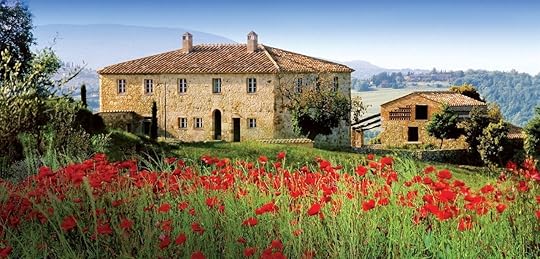
Photo: Timbers Resorts
Fractional ownership also lets you have access to, say, a farmhouse in the Tuscan countryside for a lot less than it would cost to rent.
“I go to Steamboat (Colorado) every year for a week or two. We stay in a four-bedroom unit on the mountain. If we rented that it would be $14,000 a week,” says Keith Balter, who owns one-ninth of a unit in Kiawah Island, South Carolina, and uses Timbers’ reciprocation program to trade weeks with owners around the world. “In Tuscany, we had a 3,000-square-foot farmhouse with two guest cottages and a pool. That rents for 25,000 euros a week.”
It’s not a budget purchase by any stretch; Spencer says units range from about $375,000 for a fraction of a unit in Kauai to over a million in some other places. And prices vary by how many weeks a year you want access.

Photo: Timbers Resorts
In action, the concept is pretty simple. Owners buy in different increments, from 1/12 to 1/6 of the property. That fraction is converted to weeks a year. So a 1/12 share would get four weeks. A 1/6 share gets eight weeks. You can do the rest of the math.
The units are pre-furnished, and owners have storage onsite to keep stuff like skis, golf clubs, or other stuff you’d normally keep at a vacation home.
To figure out who gets to use it and when, owners participate in something like a fantasy football draft for the weeks they want to stay. They submit their top three weeks for preference, and Timbers goes down the list and assigns weeks accordingly.
“We get about 90-95% of people getting what they ask for,” says Spencer.
Then, as owner Balter did, you can trade all but one of those weeks with owners in Timbers’ other properties, much like timeshares. You can also book time 30 days out on a “space available” basis, meaning if someone can’t use a week and turns it back to the other owners, you can use it without counting against the time you already own.
“We’ve had people who’ve stayed upward of 270 days, they know how to work the system,” says Spencer. “They’re flexible and can go on short notice. They lived 90 minutes away, could work remotely. If you can come on short notice, you can stay, there’s no cap.”
This is a little like the vacation house version of flying on a buddy pass, but if you’re cool to book all your vacations a month out it can work.
An old idea finding new life

Photo: Timbers Resorts
Fractional ownership itself isn’t new. Timbers has been around since 1999, and the concept was skyrocketing in popularity during the “YOU get a mortgage!” heyday of the mid-2000s. But like many properties of that era, fractional ownership properties were overbuilt and oversold, and the idea fizzled out.
“The system got a bit of a black eye during the credit crisis,” Spencer says. “There was a lot of stuff built in markers that couldn’t support it. And people trying to say, ‘I’ll sell it cheaper and I’ll sell more and make more product.’ But this only works if the product fits the guest profile.”
Timbers’ guest profile is, to put it plainly, rich. Average net worth of about $7.5 million rich, working on third and fourth homes. And if you’re not a third-or-fourth home kinda person, this might not be for you just yet.
“We’re not aspirational purchasers,” was, actually, the first thing Spencer told me after his name.
But someday, hopefully, millennials will be able to move out of their parents’ houses. And won’t be stuck paying $2,000 to rent a bedroom in a different kind of shared environment. Perhaps the day will come when their love of sharing will translate into a new generation of fractional owners. Or, at least, give them something cooler to call their vacation homes than “timeshares.” 

More like this: This is how much you need to make to live in 50 of the world’s biggest cities
The post Don’t call it a timeshare: ‘fractional ownership’ may be the new wave of vacation home buying appeared first on Matador Network.

New Horizons reflective balloon

It may look like a massive floating Christmas ornament, but don’t worry — people aren’t planning their holiday decorations quite yet. This reflective hot air balloon will be flying over Massachusetts this July, from Martha’s Vineyard to the Berkshires. Built with a reflective mylar coating, the balloon is meant to reflect the landscape of Massachusetts, and it will soar across the state July 12-28.
The flight is part of a public art installation called New Horizon, commissioned by the Trustees land trust, and it’s scheduled to fly to seven different properties owned by the group over the course of 16 days. These include Long Point Wildlife Refuge in Martha’s Vineyard, Edgartown’s Farm Institute, the Holmes Reservation in Plymouth, the DeCordova Sculpture Park and Museum outside Boston, Castle Hill in Ipswich, Naumkeag in Stockbridge, and Field Farm in Williamstown.
“New Horizon is a 21st-century version of a journey,” the Trustees’ website says, “traveling through the landscape by air. The project is composed of a series of live events across the state of Massachusetts. At each stop, the mirror balloon touches down becomes a happening. It is both an artwork and an event where ideas, conversation, music, and art are shared.”
Pedro Alonzo, the guest curator for the Trustees’ contemporary arts initiative, said, “This is not the kind of thing that happens regularly — and it’s not the kind of thing that happens in Massachusetts. There are many wonderful, beautiful things to come out of the state, but they tend to be more academic, more research-driven, more sober and business-minded. This kind of art is very rare, and I see it as a real opportunity for people to experience something unique.”
The balloon’s flight path and performance schedule can be found online. Tickets will be available for visitors to board the balloon during each of its stops. 
H/T: Travel & Leisure

More like this: The 7 most amazing places to go hot-air ballooning around the world
The post Giant reflective balloon to soar over Massachusetts this summer appeared first on Matador Network.

Traditional Ecuadorian dishes

While tiny in area, Ecuador has it all when it comes to food. The platos típicos, or traditional dishes, vary widely depending on the culture and climate in each region. Despite some similarities, you can find differences in the main three geographical regions: Costa (along the coast), Sierra (the mountainous region), and Oriente (the east, where you’ll find the Amazon). There are plates that incorporate medicinal plants from indigenous tribes and those that draw from religious customs from Spain. And, of course, the hearty comfort foods for chilly nights in the Andes mountains.
Lunch is what unites the country. As the most important meal of the day, you can expect heaping platefuls of food. Families sit down to a courses-long menu with soup, a main, dessert, and a drink.
With such a range of traditions and geography, there’s always something to try in Ecuador. Don’t miss these 12 dishes, drinks, and desserts.
1. Fanesca

Photo: Vicente Garces Custode/Shutterstock
This lentil soup is an Ecuadorian smorgasbord served only during Easter and Lent. Fanesca takes days to prepare and uses 12 local legumes and grains to represent the 12 apostles. Salt fish, a food connected with Jesus, is the basis of the broth. Outside of these ingredients, each chef has a coveted personal recipe.
A bowl can have corn cobs, cheese, avocado, tiny empanadas, fried plantains, and other ingredients thrown on top. During Easter weekend, look for restaurant signboards that say Hoy fanesca!, meaning “Today, there’s fanesca!”
2. Cuy
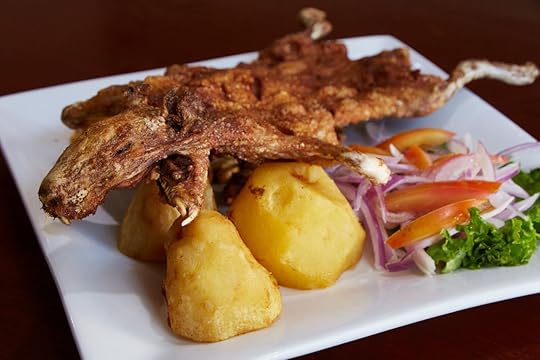
Photo: anna mori/Shutterstock
Cuy, or guinea pig, could be called the “turkey of the Andes” because its flavor and texture is very similar to dark-meat poultry. These grass-eating, space-saving animals are one of the most sustainable types of livestock on Earth.
It’s served fried, which can be a bit greasy, and al horno, or baked. Often, a full cuy is roasted on a spit above potatoes, which catch the drippings and are served as a side dish. Cuy is served whole or quartered and is almost always presented with the head. Specialty cuy restaurants sell them as full meals with potatoes and salad, just look for cartoon guinea pigs on storefronts to find it.
3. Llapingachos

Photo: Ecuadorpostales/Shutterstock
Llapingachos ( pronounced yap-in-gah-chos) are fried cheesy potatoes that are fun to say and to eat. They’re made with balls of potato dough stuffed with stringy cheese that’s fried flat like pancakes. These cheesy, crunchy snacks are served with aji, a spicy Ecuadorian fresh salsa made with local chili peppers. You’ll see llapingachos both as a side dish and street food in markets across the country.
4. Encebollado

Photo: Fotos593/Shutterstock
Ecuador’s national dish is also the country’s hangover cure. This comforting tuna soup is made with cassava, a sweet and stomach-soothing root vegetable; tomatoes; and onions. Encebollado, meaning “onion-ed,” gets its name from the red pickled onions used to garnish the top. This soup is found all along the coast but also in major city centers, helping locals perk up after a night out dancing to cumbia or bachata.
5. Ceviche
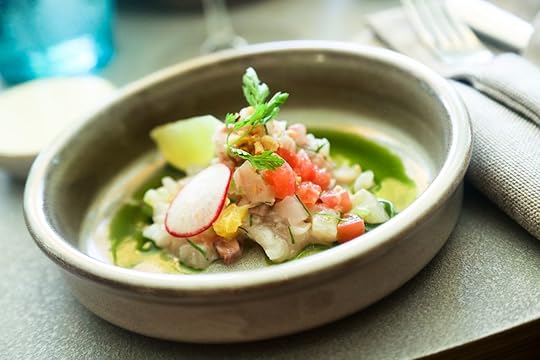
Photo: MariaKovaleva/Shutterstock
Those who love fish with lemon will swoon for this seaside specialty. They’ll also get a taste of a major food controversy over whether ceviche originated in Peru or Ecuador.
Ceviche is prepared by soaking raw fish or seafood in a citrus broth. The acid in the citrus denatures the proteins, and the fish becomes firm as if cooked with heat. Along the country’s beaches, Ecuadorian ceviche comes in a cold bowl of leche de tigre (“tiger’s milk” made with lemon, onion, cilantro, and fish broth) with a side dish of popcorn.
6. Trucha al horno
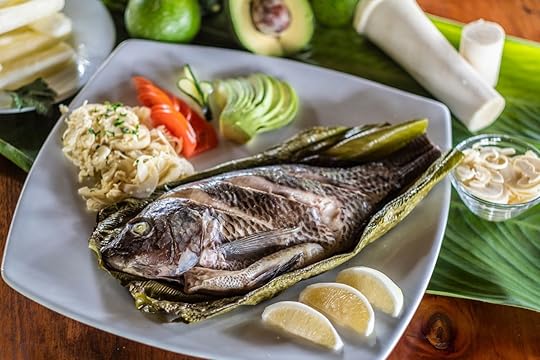
Photo: a35mmporhora/Shutterstock
Trucha, or trout, may be an invasive species in Ecuador, but it’s also become a staple in Andean cooking. Scored and roasted in an oven, the crispy skin of the trout keeps the inner meat juicy.
Fishing ranches in the Andes offer a chance to catch your own or sit down for a plate at the on-site restaurant. Like most meats here, trucha is served with starchy side dishes of mote (large savory corn kernels), rice, or potatoes.
7. Horchata
View this post on InstagramA post shared by Laylita.com (@laylita_com) on Jul 27, 2018 at 10:43am PDT
You’re probably familiar with the creamy Spanish or Mexican version of horchata, but Ecuador’s take on the drink is quite different. Typical to the province of Loja but consumed country-wide, Ecuadorian horchata is a fragrant, bright pink-red herbal tea made with wildflowers, herbs, and sweetened with honey. Each family’s recipe is distinct and can include more than 12 medicinal ingredients said to aid digestion, memory, and decrease inflammation. Horchata can be consumed hot as a tea or chilled. When cold, the iced tea is sometimes called agua fresca, or fresh water. The beverage is widely available in cafes and markets and is always steeping on local stovetops.
8. Morocho

Photo: Ildi Papp/Shutterstock
Ecuador’s ultimate creamy comfort food. Morocho is made with cinnamon, ground mote (a savory corn), milk, sugar, and raisins. The mote has a texture like oatmeal and sits on the bottom of the glass. Morocho is a popular breakfast food in markets, on menus in some restaurants, and now has popped up in a few fast food chains paired with empanadas.
9. Quimbolitos
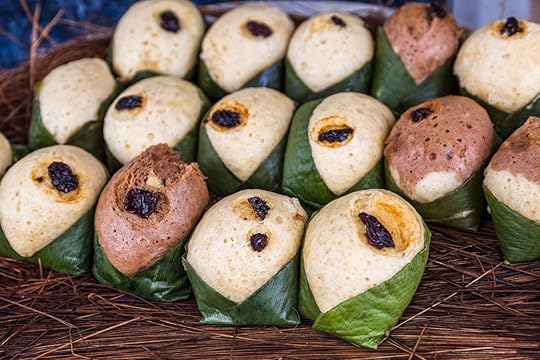
Photo: Ecuadorpostales/Shutterstock
These cozy, buttoned bundles are a common sight in pastry shop windows and on cafe menus. Quimbolitos are a palm-sized sweet cornbread speckled with raisins and steamed in a banana leaf to lock in flavor and moisture. The batter is a mix of corn, wheat flour, sugar, and creamy cheese that adds a pleasant saltiness. Many locals enjoy quimbolitos during cafesito, or afternoon coffee.
10. Espumillas

Photo: Bibarama/Shutterstock
Espumilla means “mousse,” and this raw meringue dessert is made with fruit, egg white, sugar, and vanilla or chocolate depending on what flavor you order. It’s sometimes decorated with candies or fresh berries and is used as a jello topping. Often, this sweet, whipped dessert is served up on cones, making it easily mistaken for ice cream.
Find it at colorful, swirling espumilla carts in city plazas that cater to the families who gather there after school.
11. Hornado
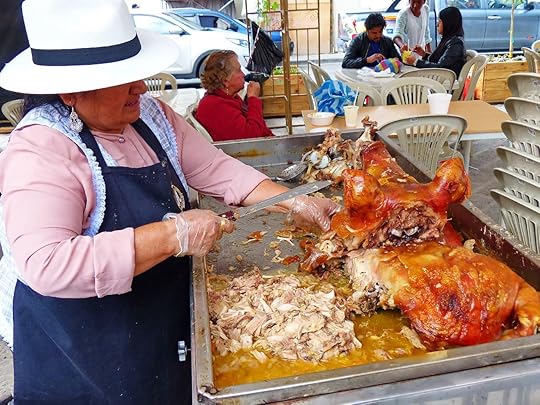
Photo: ireneuke/Shutterstock
Hornado is Ecuador’s slow-roasted pig on a spit. Juicy meat is served with pieces of decadent crackling, which is the crispy, salty skin.
At markets, you’ll hear a section of vendors shouting and waving samples to entice you away from the competition. Once ordered, the owner selects the most succulent pieces of meat, tops them with crunchy skin, and places it all on a bed of mote or potatoes. Then, the dish is sprinkled with a handful of fresh onions, tomatoes, and cilantro to add freshness.
Ecuador’s most famous hornado is found in Riobamba and outside of Cuenca in the Gualaceo Market.
12. Chicha

Photo: Alekyjas/Shutterstock
This “jungle beer” is a slightly sour and effervescent alcoholic drink made from fermented yuca, a starchy jungle root. Traditionally, chicha was made by the mouths of matriarchs in jungle tribes. The women would chew the yuca then spit it into a large gourd container. After a few days, the natural yeast and sugars in the mix fermented the liquid.
Today you can sample chicha spit-free in Ecuador’s rainforest towns, which is good because it’s a huge insult to turn down chicha. After all, it’s a very personal brew. 

More like this: Ecuador packs the most adventure into a small space better than anywhere else in South America
The post 12 dishes that prove Ecuadorian food is highly underrated appeared first on Matador Network.

Traditional dishes from New Zealand

Long before European settlers came to New Zealand, there were the Māori. Māori people migrated from Polynesia, and their diet was a mix of ingredients native to New Zealand (or Aotearoa) and those brought with them in their travels. They relied heavily on kai moana (sea food) and the kai whenua (food from the land), including kumara (sweet potato), yam, taro, kiore (Polynesian rat), and kurī (Polynesian dog).
A lot changed with the arrival of European settlers. Pigs, goats, and hens — along with crops such as carrot, potato, cabbage, and wheat — changed the Māori diet. In later years, farming and agriculture became the country’s largest industry, and beef and lamb became staples along with milk, butter, and eggs. Today, you can find a wide variety of international cuisines in New Zealand along with traditional Māori dishes.
This mix of cultures makes New Zealand a great place for food lovers. These are the dishes and food traditions you need to partake in on your next trip to New Zealand.
1. Hangi

Photo: Irena Alexander/Shutterstock
The Māori cooked their food in an underground oven called a hangi. Fish, meat, and root vegetables were wrapped in leaves, placed on top of hot stones, and earth was piled on to keep the heat in. This cooking style fed a large number of people at once though it takes hours from start to finish.
Today, hangi are normally only prepared for special occasions or at Māori tourist spots. Wet cloth or aluminum foil is used to make the process easier. Ingredients also now include pork, lamb, cabbage, potato, and pumpkin, which are placed in wire baskets.
2. Whitebait and other fritters

Photo: Maggie McManus/Shutterstock
The Maori cooked whitebait, which are near-transparent fish around two inches long with a delicate fishy taste, by steaming them in a hangi in flax baskets. The Europeans added whitebait to fritters with egg and batter. Whitebait season runs from August to mid-November, and when available, they’re one of the most expensive fish in New Zealand.
Pipi, a common shellfish on the island, and mussels are also made into fritters. Pipi are slightly peppery, like clams but smaller and chewier with a stronger flavor.
3. Meat pies

Photo: NaturalBox/Shutterstock
Meat pies are found at bakeries, supermarkets, gas stations, and dairies (local food stores). New Zealand loves its meat pies in a number of different combinations, and the country even has a national award for the best meat pie called The Bakels. Made with shortcrust or flaky pastry, typical meat pies are about five inches in diameter. Around since the late 1800s, steak or mince (ground beef) with a little gravy were common, as were meat pies made with chicken, bacon, and egg. Today, you’ll find all manner of meat pies both sweet and savory. The Bakels separates the pies into 13 categories: mince and gravy, steak and gravy, chicken and vegetable, gourmet fruit, gourmet meat, vegetarian, bacon and egg, mince and cheese, steak and cheese, potato topped, commercial, café boutique, and supreme.
4. Pavlova

Photo: bonchan/Shutterstock
Pavlova is a meringue cake made with eggs, sugar, vinegar, and vanilla. It’s baked slowly and is hard on the outside, soft and gooey on the inside. There’s a hot dispute as to whether New Zealanders or Australians invented this sweet dessert, but it’s known that it’s named after Russian ballerina Anna Pavlova who visited the region in 1926. Regardless of which island it comes from, Pavlova is a favorite dessert, especially during Christmas, and is traditionally decorated with whipped cream, strawberries, and kiwi.
5. Anzac biscuits

Photo: AS Food studio/Shutterstock
The Anzac biscuit is another disputed favorite between New Zealand and Australia. It’s made with rolled oats, shredded coconut, flour, sugar, and butter, and it’s forever tied to the Australian and New Zealand Army Corps (ANZAC). The biscuits were made and sold to raise funds for the war effort during World War I and were sent to soldiers because they don’t spoil easily. Anzac biscuits are sold commercially today and have kept the military connection.
6. Cheese rolls
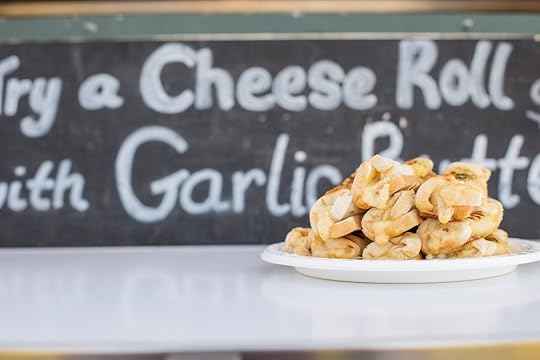
Photo: Tourism New Zealand
Popular on the South Island, these savory snacks are relatively unknown on the North Island. The snack is made with a slice of bread filled with a cheese, onion, and spice mixture that’s rolled into a tube shape and toasted. The first recipes are from the 1930s, and popularity really took off in the 1950s. The modern version uses cheese, a can of evaporated milk, and a packet of onion soup mix. You can find cheese rolls in cafés, cafeterias, and food stands. 

More like this: Wellington is the most underrated destination in New Zealand. Here’s why.
The post 6 dishes that shaped New Zealand, from traditional Māori to post-European appeared first on Matador Network.

Best bike paths in Tulsa, Oklahoma

There are lots of ways to explore a city. Tulsa, Oklahoma’s second city but the city most deserving of your visit, has received Bike-Friendly Community awards since 2009 from the League of American Bicyclists, making it one of 430 communities designated as such in the US. Moreover, Bicycle Magazine listed Tulsa as one of the Top 50 cities in America for bike-friendliness. Undoubtedly, one of the best ways to explore Tulsa is on two wheels. Here’s how to do it.
What makes Tulsa so bike-friendly?

Photo: Sean Pavone/Shutterstock
Turning an infrastructure built for driving into one optimized for cycling is no small task, and it’s a project that Tulsa has been chipping away at for years. Aside from numerous trails in and around Tulsa, great strides have been taken to make the city more bike- (and pedestrian-) friendly. One of the most notable advances is the new bike share program, aka This Machine, the first phase of the Tulsa Bike Share initiative. This Machine is designed to expand the cycling culture by providing both a high quality and affordable option for residents and visitors. With 160 bikes available across 25 stations throughout downtown and along Route 66, there is always a bike nearby if you need one.
Phase Two is coming soon to expand This Machine to other popular areas of Tulsa, including the Pearl District, Cherry Street, and Gathering Place. Visitors wanting to pedal through town can rent single 30-minute rides for $2 or grab a three-day pass for just $10. Keep in mind that even with the multi-day option, bikes are still subject to the 30-minute increments. In other words, they want you to lock the bike up at each stop and not just leave it sitting around unwatched. If you’re in Tulsa for a more extended period, you can also purchase monthly and annual memberships rather economically.
Download the BCycle app and explore downtown Tulsa and Route 66. There are plenty of stops along the bike-share system map that take you to cultural attractions like the Philbrook Downtown museum and DECOPOLIS, a super-hip Art Deco museum in the heart of the city. Alternatively, art enthusiasts might enjoy hunting the many downtown murals while sports fans can pay a visit to the Tusla Drillers, a Minor League Baseball affiliate of the Colorado Rockies, at ONEOK Field. Of course, do not leave Tulsa without defying the laws of physics in the Center of the Universe, quite possibly the freakiest place you’ll visit this side of the Stanley Hotel.
Explore the River Parks Trail system.

Photo: Stephanie A Sellers/Shutterstock
A local bike advocacy group called The Tulsa Townies offer free bike rentals available at stations throughout the city’s extensive River Parks Trail system. There is no cost to borrow a bike, but you will have to provide identification and a credit card in order to prevent theft. To fully explore the area on a bike, I recommend starting here with the namesake River Parks Trail. This path is ideal for any fitness level and guides you to some of the top spots in Tulsa. You can start downtown and ride the East Bank Trail that extends nine miles to 101st or vice versa using the West Bank Trail. This is a good afternoon exercise lined with well-marked pull-offs for a drink, a picnic, or a scenic view. If you’re a road warrior looking to conquer a longer distance, you can extend your route at trail connections on either end. The best resource for mapping out over 80 miles of trail is on the INCOG website, which also provides handy trail closure updates.
More leisurely explorers can easily spend the whole day riding along the Arkansas River. Tulsa’s new pride and joy, The Gathering Place, is located just off the trail on the East side and is a must stop for anyone visiting Tulsa. This mammoth riverfront park opened in 2018 and features a fitness trail, massive playgrounds, and art exhibits. The park is so extensive that it actually has its own app to help visitors plan their way around and stay on top of happenings.
For dinner by the water or a post-ride brew, slide into Blue Rose Cafe or Elwood’s. These two local favorites are situated together right along the River Parks Trail, and both offer excellent patio dining, classic menus, and ice cold beer to refuel. The following trails connect with the River Parks Trail and take you through a variety of experiences, both urban and wild.
Head away from the hustle and bustle.

Photo: Sean Pavone/Shutterstock
If you’re an experienced rider and feeling a little adventurous, take a trip through the Turkey Mountain Wilderness. Turkey Mountain connects to the River Parks Trail on the West Bank at 71st. Here you can immerse yourself in the “wilderness” along several miles of dirt trails and wind through this 300-acre park. It can be challenging for the casual rider, and you may even forget you’re in the city at all.
The area is truly kept in a wilderness state, meaning that if you take this trail on, practice typical safety precautions related to remote exploring. The park discourages solo riding and/or hiking and recommends sturdy footwear, ample water supply, and a cell phone with GPS tracking. Be sure to dress appropriately for the weather AND the environment. Nobody wants to end the day covered in poison ivy.
Or take the peaceful path downtown.

Photo: 4kclips/Shutterstock
Connect to the Aquarium Trail at the south end of River Park East at 101st. This trail offers beautiful views of the Arkansas River and access to the Oklahoma Aquarium, as well as several shops and restaurants at Riverwalk Crossing. If you’re feeling hungry, Los Cabos Mexican Grill is home to some of the best Mexican food in town while Burn Co serves up some of the meanest BBQ in the state.
The Midland Valley Trail is somewhat of a local secret, a wooded path that makes a peaceful alternate route downtown by connecting to the Riverside East Trail near the Gathering Place. This beautiful bike path runs alongside an old abandoned railroad as well as in and around the most impressive parks in Tulsa. If you love ever-changing scenery, Midland Valley is for you because you’ll soak in many aspects of Tulsa on your way into the city center. It’s the perfect introduction to Tulsa. 

More like this: How to plan a summer mountain bike trip to Andorra
The post Tulsa is one of the best cities in America to explore by bike appeared first on Matador Network.

What to see and do in Armenia
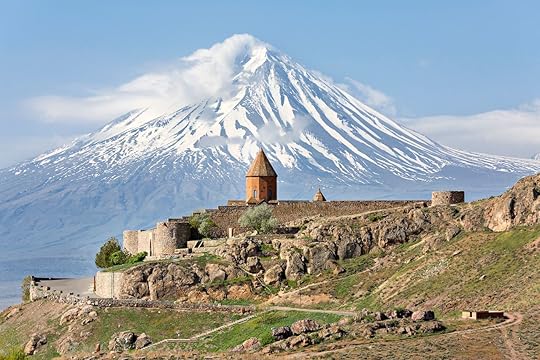
Asia is on the rise as a popular summer vacation destination, and Europe has been a perennial favorite for over a century, but the region in between has been unduly neglected by travelers. Occupying a unique cultural space that isn’t quite European or Asian, the countries of the South Caucasus have flown under many travelers’ radars — particularly Armenia, one of the most picturesque and diverse places in the world. If you want your next vacation to be truly unique, you should start brushing up on this under-traveled country between Turkey and Azerbaijan.
Beyond the fact that the Kardashians are Armenian — though that’s not really the country’s fault — the place is largely unknown in the public conscious. Whether you visit for the stunning mountain landscapes and hikes, the ancient and delicious cuisine, or the rich history, you won’t regret making Armenia your first stop in the South Caucasus. Here’s why Armenia needs to be on your travel list this summer.
Ancient history and beautiful traditions
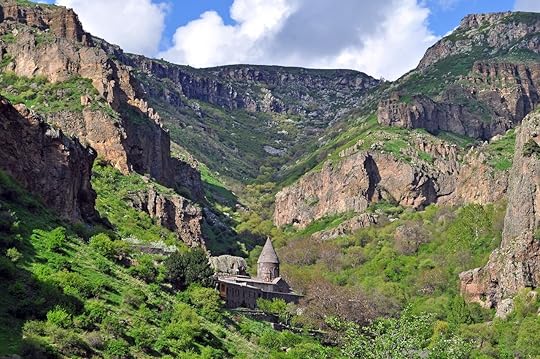
Photo: Govorov Evgeny/Shutterstock
Even for history buffs who pride themselves on the depth of their knowledge, Armenian history is probably a mystery. As the first country in the world to adopt Christianity as a state religion in 301 AD, Armenia is home to the first Christian cathedral in the world. The Etchmiadzin Cathedral, completed in 303, is still standing in the town of Etchmiadzin and is the religious center of all Armenians to this day.
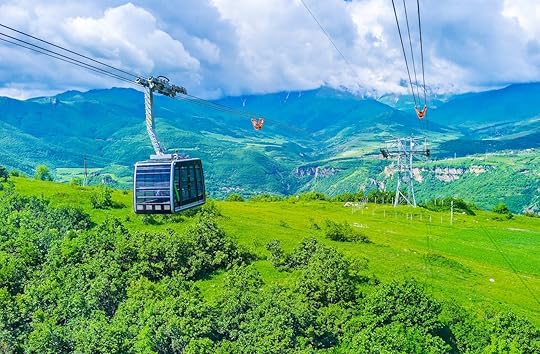
Photo: eFesenko/Shutterstock
Centuries-old monuments of Christianity can be found all over Armenia, defined by their medieval architecture. Make sure to check out the Monastery of Geghard in the Kotayk province. The monastery is over 800 years old, composed of several churches and tombs carved into the rock and set against the backdrop of dramatic cliffs of the Azat Valley. The ninth-century Monastery of Tatev is also worth a visit. This Armenian Apostolic monastery is located on a plateau in the Syunik Province and serves as a scholastic center of enlightenment and spirituality. To reach the monastery, take the 3.5-mile tramway to the top of the plateau — the longest tramway of its kind at the time of its construction — or drive 40 minutes up the switchback road of the Vorotan Gorge.

Photo: MehmetO/Shutterstock
If you’re someone who loves bringing souvenirs home from your travels, but you’re not exactly looking for a cliche refrigerator magnet, you’ll be thrilled by what you can find in Armenia. The Armenian Highlands are considered by many historians to be the birthplace of the eastern carpet, and the tradition of carpet-weaving is deeply rooted in Armenian culture. The Megerian Carpet gallery and factory in the country’s capital, Yerevan, displays carpets from the 16th to 19th centuries and even offers them for sale. If you want a truly authentic souvenir that speaks to the country’s history and tradition, it doesn’t get better than an Armenian carpet.
Stunning mountains and a lake that reflects the sky

Photo: MehmetO/Shutterstock
One of the most defining features of Armenia’s natural landscape is Mount Ararat, with a peak soaring to 16,854 feet. Although technically located across the border in Turkey, Ararat holds immense significance for Armenians as a symbol of their motherland. In the Biblical story of the Great Flood, Mount Ararat was where Noah’s ark was said to have landed, and according to the story, Noah settled the Ararat Valley with his family. The best views can be had from the observation area in Victory Park or the Monastery of Khor Virap in the Ararat plain.
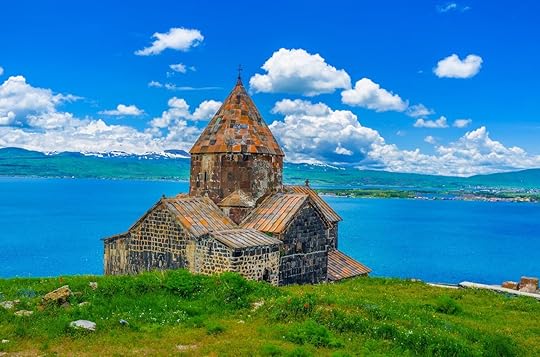
Photo: eFesenko/Shutterstock
If you’d rather venture into the mountains than simply stare at them, a trip to Lake Sevan deep in the Caucasus Mountains is a must. The lake is so high up that the surface of its water sometimes appears to touch the sky. As the largest lake in the country, Armenians often refer to it as “the Armenian Sea,” and visitors could easily spend a whole summer’s day relaxing by the warm water. There’s even a ninth-century monastic complex nearby called Sevanavak, which could really round out your day trip to the mountains.

Photo: Pavel L Photo and Video/Shutterstock
To really plunge into the mountains, take one of the hiking trails through the Tavush region in the northeast. The Dilijan National Park is not only home to oak forests, deep gorges, and an abundance of streams but also to the Transcaucasian Trail, two connected long-distance hiking trails spanning over 1,864 miles through the Caucasus region.
The southern route, through Georgia and Armenia, connects the mountain villages and gives hikers incredible views of the surrounding valleys, mountain peaks, and the Black and Caspian Seas. If hiking these epic trails doesn’t get your blood pumping, the Armenian mountains have become a popular location for paragliding, especially around Dilijan, Mt. Atis, and Lake Sevan. And in the winter, the Tsaghkadzor ski resort is buzzing with visitors looking for a dose of winter adrenaline — and it’s far more affordable than the Swiss Alps.
Some of the best food in the world

Photo: golubovystock/Shutterstock
Armenia has one of the oldest and most delicious culinary traditions in the world. Spas is a creamy soup made with fermented Armenian yogurt called matsun, and it’s served by many traditional restaurants in Yerevan and around the country. Armenian kyufta (meatballs) or tolma (grape leaves stuffed with minced meat) are also local favorites, as well as khorovats (juicy barbeque). Lavash, Armenian pita bread, is so world-renowned it’s even been included in the UNESCO Intangible Cultural Heritage List, and many use it to wrap basturma — dried meat with spices. To satisfy your dessert craving, you need to try gata, a puff pastry that comes in a variety of shapes and sizes, with many regions having their own version.

Photo: Ninell Creative/Shutterstock
Since the temperate Armenian climate is perfect for producing large quantities of healthy fruits and vegetables, markets and shops are always packed with a wide range of veggies, fruits, and berries. The golden Armenian apricot is perhaps the country’s most famous piece of produce, as it absorbs the sun’s bright rays to give it its golden hue. Indeed, the apricot is said to have originated in Armenia and is considered an important symbol for the country. Armenian apples, peachesi, plums, grapes, figs, and pomegranates are also ubiquitous in the country, and they’re even popular abroad for their uniquely juicy flavor.
When it’s time to wash down the local fare, you can save yourself time Googling “Is it safe to drink the water in Armenia?” The answer is yes, the water is not only safe but some of the purest in the world. Armenia’s water comes from natural mineral sources, and its clean taste isn’t lost on Armenians. In honor of the city’s 2,750th anniversary in 1968, 2,750 water fountains were installed around Yerevan, dispensing clean, refreshing water to residents. The water in the town of Jermuk is even rumored to have healing properties — according to ancient legends. 

More like this: Central Asia is the next big trending destination. Here’s why.
The post Armenia is the most fascinating place you can visit this summer appeared first on Matador Network.

JFK’s TWA Hotel will have food hall

JFK Airport’s new TWA Hotel — the revival of the airport’s long-abandoned terminal — continues to make additions that will make travelers actually look forward to passing through JFK. Last month, the hotel announced the installation of an infinity pool with views of the runaway; now, in addition to the pool, a museum, and several bars, the hotel is adding a food hall intended to offer quick and affordable dining inside the terminal’s “Departures Hall” where Trans World Airlines passengers used checked in for flights.
The hall will be filled with local NYC favorites like the Halal Guys and Empanada Mama. Other stalls will include Earl of Sandwich, Fresh&Co, and Playa Bowls. Daily menus for each food stall can be found on Fooda’s mobile app.
According to Tyler Morse, CEO of MCR/MORSE Development who developed the project, the goal of the space is to offer “essential New York City food bucket list all in one spot.”
The TWA terminal is scheduled to open on May 15, including a hotel with 512 rooms and a range of bars and fine dining options in addition to the food hall. 
H/T: Eater

More like this: Where to eat and drink at the Denver International Airport
The post JFK’s new TWA Hotel will have a food hall filled with local favorites appeared first on Matador Network.

Whale returns phone dropped in sea

Last week, fishermen in northern Norway reported seeing a beluga whale behaving strangely, seeking out vessels, pulling straps and ropes from the sides of boats. The beluga was wearing a harness that seems to be meant to hold a camera or a weapon with the inscription “Equipment of St. Petersburg.” The harness was promptly removed from the marine animal, which is believed to be a spy whale that has defected from the Russian Navy.
Since it’s been found and freed from its contraption, the whale hangs out around the harbor town of Hammerfest and performs tricks and leaps in the hopes of getting fish from visitors, who have even been able to pet the animal.
Whether the animal is a spy or not, it’s definitely has been trained to fetch what is thrown at him.
Recently, local Hammerfest resident Ina Mansika went down to the waterfront with her friend to hopefully catch a glimpse of the beluga when she accidentally dropped her phone in the water.
Mansika told The Dodo, “We laid down on the dock to look at it and hopefully get the chance to pat it. I had forgotten to close my jacket pocket and my phone fell in the ocean. We assumed it would be gone forever; until the whale dove back down and came back a few moments later with my phone in its mouth!”
View this post on InstagramA post shared by ISA OPDAHL LARSSON | 21 (@isa.opdahl) on May 5, 2019 at 9:20am PDT
The Russian defense ministry has denied running a sea mammal special operations program, but reports mention that the Russian navy has been training beluga whales, among other animals, for military purposes.
One thing for sure is that the whale should not be pet or fed as it needs to stay away from humans and be able to forage to survive on its own. Experts hope the animal will find a pod of beluga to join and swim away to live with its own as a free whale. 
H/T: The Dodo

More like this: 10 hotels that are perfect for whale watching this spring
The post Beluga whale returns phone woman dropped into the sea appeared first on Matador Network.

May 6, 2019
Reasons to visit Greensboro, NC

North Carolina has low-key climbed the tourism totem pole.
Where North Carolina once straddled the deep South and the mid-Atlantic has deftly taken its combination of mild weather, serene beaches, and adventure-filled mountains and turned itself into the California of the East. Luring young families, snowbirds, college students, and retirees to its lush pine forests and soft rolling hills.
That population has turned places like Raleigh, Asheville, Wilmington, and Durham into legitimate weekend destinations. Cities with character, history, and rich southern food that make for a relaxing getaway most times of year. But in the middle of North Carolina, long-overlooked Greensboro is quietly turning itself into North Carolina’s next great destination — taking its own nature, fascinating history, and creative culture to make a city worth visiting for a lot more than the ACC tournament. Here are seven reasons Greensboro needs to be on your radar.
1. Downtown does it right.
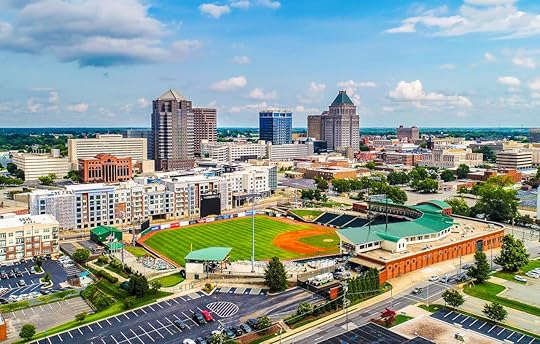
Photo: Kevin Ruck/Shutterstock
Greensboro has done a masterful job with its main drag, which next year will be anchored by a new performing arts center on one end and a funky neighborhood full of breweries and thrift shops on the other. Elm Street is full of the kind of old brick facades you see in nostalgic black-and-white photos, the buildings now occupied by craft taco shops, a regional theater company, wine bars, and modern southern restaurants.

Photo: VanderVeen Photographers/Visit Greensboro
On a sunny Saturday I spent the better part of an afternoon participating in Downtown’s annual Sip n’ Stroll event, a sort of bar and restaurant crawl through downtown. I began in City Center Park, a model of public green space where the Korean Festival had taken over the bandshell. There I had a glass of wine at Café Europa in the adjacent LeBauer Park while kids cooled off in a splash pad nearby. We walked from there down Elm, stopping at 1618, a bistro-wine bar, and Stumble Stilskins, a Boston-style Irish dive. The journey ended at a pair of breweries near the railroad tracks — Little Brother and Natty Greene’s.
Surrounding Downtown is the Greenway, a four-mile loop of biking and hiking trails that’s the perfect way to get the lay of the land. It’s ideal for a morning run to get a sense of all you’ll want to see later.
2. The history is fascinating.
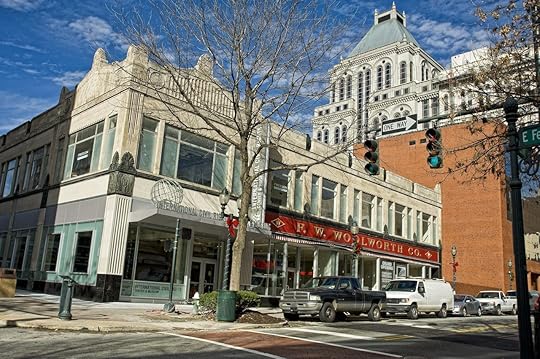
Photo: The International Civil Rights Center & Museum
Greensboro is the birthplace of Vicks Vap-o rub, a fun fact you’ll learn on one of the many historic plaques running through downtown. But the history here runs much deeper than medicinal pastes. Greensboro is also the home of the Woolworth’s Lunch Counter, where four black students began the lunch counter sit-in movement in 1960. The counter is still there, but the Woolworth’s that housed it is now the International Civil Rights Museum, one of the most unique exhibits on the American black experience.
The museum is not a simple collection of artifacts but an uncomfortably designed space where you’re guided by a poet or other artist who explains — in powerful language — how the United States has treated people of color. Through graphic photos of lynchings, purposefully cramped spaces made to simulate “colored only” areas of the Jim Crow era, and numerous short films, the museum is as much a message as it is an education.
Its centerpiece is the old lunch counter, which stands just as it did in 1960, minus a few stools that have been shipped off to the Smithsonian. The museum also doesn’t allow photos, as it’s meant for quiet reflection, not Instagramming.
3. Outdoor recreation is accessible to all.

Photo: Visit Greensboro/Facebook
Though the mountains near Asheville and the beaches on the coast get much of the Carolina outdoor hype, sparsely populated Greensboro has a magnificent system of hiking and biking trails that make it an outdoor destination anyone can enjoy. That’s because the trails are, for the most part, easy. So even if you’re not usually an active vacationer, you can get lost (figuratively) among towering Magnolia and pine trees, with nothing but the sounds of birds and the lapping of water accompanying your morning stroll.
The bulk of the trails are based around a watershed maybe 15 minutes from downtown. Trails surround the lake where you’ll find water peeking out from behind the trees as you meander its soft elevation gains. The city of only about 300,000 doesn’t jam the trails either, as on a seven-mile hike through the Nat Greene trail one Saturday I encountered maybe a dozen other people.

Photo: Visit Greensboro/Facebook
Again, the hiking here is easy, so it’s not a destination for the hard-core outdoors folks. But the flat, peaceful trails create an environment ideal for even those who don’t exercise much. In addition to the trails, the watershed area has numerous boat, kayak, and stand-up paddleboard rentals if you’d rather enjoy the Carolina sun from the lake.
4. Greensboro has seasons, but it’s never too cold.

Photo: Sean Pavone/Shutterstock
The great outdoors isn’t seasonal either. While I was fortunate enough to visit in mid-April, with cool mornings, sunny afternoons, and pleasant, chilly evenings, Greensboro rarely gets too cold or too hot. December and January bottom out with highs in the low 50s. Not exactly tanning weather but cool enough to let you know summer is gone.
Summer can get a little humid, like most of the South, but under the shade of the thick trees or out on the water you barely notice temps in the upper 80s. It’s the kind of mild climate that draws throngs of people from the Northeast tired of the cold and Floridians sick of brutal summers and hurricanes. It also means you can plan a trip here and never worry about getting rained out.
5. Greensboro does way more than just Southern food.
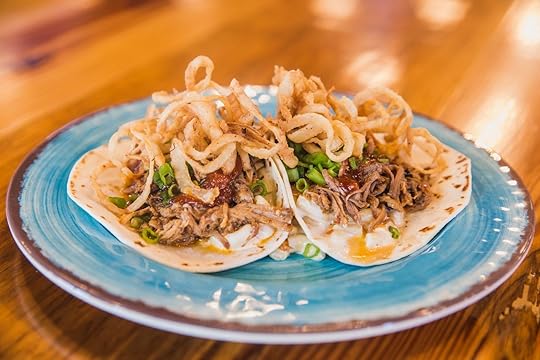
Photo: Crafted
Every, and I do mean every, small-to-midsize city in America seems to tout its up-and-coming food scene. Greensboro is no exception, and like many cities its size, you’ll find enough first-class restaurants to fill a long weekend.
Chef Kris Fuller, who with her short hair, tattoos, and gauges in her ears looks like she just stepped off the set of Chopped, has food worthy of the show too. Her series of Crafted restaurants are the approachable best bet for trying something different in Greensboro. Hit the downtown Art of the Taco for southern-inspired tacos filled with stuff like pulled pork and mac and cheese.
Blue Denim — so named after Greensboro’s history as the home of Lee and Wrangler Jeans — is probably the culinary star of the city, offering Cajun specialties like crawfish beignets and shrimp and oyster po’ boys.
On Elm Street I had the best falafel I’ve tasted outside Israel at Jerusalem Market, a family-run fast-casual spot with a sunny back patio.
Venture into the Lindley Park neighborhood and get possibly the best pizza in the state at Sticks and Stones. The brick-oven pizzeria serves cold local beers on an outdoor patio. Slinging pies topped with local ingredients like the Sweet Carolina with Cane Creek farm sausage, wood-roasted chiles, and local spinach.
6. You’ll find creative hotels, restaurants, and bars where you’d usually see chains.

Photo: 1618 Midtown/Facebook
Greensboro has a lovely historic downtown, but unlike a lot of newer cities, it also hides a lot of its gems in strip malls and nondescript office parks. I realized this when looking for late-night dining (one area where Greensboro still lacks) and happening upon 1618 Midtown, tucked into a nondescript shopping strip near a Walgreens. I sat at the bar and began chatting with the bearded bartender while waiting for a chorizo rice bowl and truffle fries. His name was Max Barwick, and he was the sort of bartender who sees you looking at a menu, asks what you like, then makes something completely off the menu.
“That guy won a huge international competition in New Orleans,” a slightly tipsy regular at the bar next to me said. “He’s a big deal.”
Barwick returned with a mezcal-jalapeño-lime concoction that tasted like he’d read my mind. I asked him about the award and he humbly told me he’d won the Cocktail Classique in New Orleans in 2018 with a drink called Bitter, Party of One.
“Everyone else there was from Brooklyn,” he said.

Photo: Proximity Hotel/Facebook
Not far away I found myself wandering through an office park and finding a towering, modern-gothic building standing up through the night fog. It was the Proximity Hotel, a boutique property that looks like an old converted bank, set among the kind of places banks now call home. It is far-and-away the most unique modern hotel in the city, with all the boutique staples like subway tiles in the bathroom, luxury bath products, vintage furniture, and high-tech gym equipment.
It’s also home to Print Works Bistro. It felt like more of a destination restaurant than a spot stuck in a suburban hotel, with gourmet flatbreads and tuna tartare leading into a menu full of stuff like lemon garlic shrimp risotto and bacon-wrapped meatloaf. It’s an example of how Greensboro has put emphasis on areas many cities neglect.
7. People haven’t discovered it… yet.
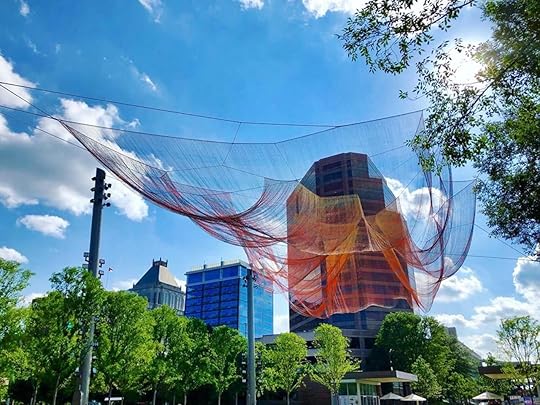
Photo: Downtown Greensboro/Facebook
Greensboro isn’t the first midsized southern city to offer this sort of amenity-filled escape to a smaller place. Asheville, Chattanooga, and Greenville, SC, come to mind for beer or adventure or world-class food. And not that any of those places have become overrun with tourists, per se. But you won’t be avoiding crowds in any of them either. Greensboro offers many of the same things those great destinations do, with nary another visitor clogging up your bike trails. And as the city continues to learn from others’ mistakes and offer more for visitors every year, it likely won’t stay that way for long. 

More like this: How to eat like a chef in Asheville
The post 7 reasons Greensboro is North Carolina’s next great destination appeared first on Matador Network.

Central-Mid-Levels escalators in HK

Among Hong Kong’s many accolades — including being a global hub for both finance and street food — one is responsible for moving you about the commercial district with ease, and we’re not talking about tuk-tuks, motorbikes, or even Uber. This Special Administrative Region off the Chinese coast is home to the world’s longest outdoor covered escalator system. Stretching over 800 meters, or about a half mile, and gaining 135 meters in elevation, the Central-Mid-Levels Escalator system carries more than 85,000 people on its 18 escalators and three inclined travelators every day.
This byway is among the most unique charms of the city, home to incredible food and plenty of shopping. The system moves enough interesting characters that keeping focused on the task at hand (riding — and successfully exiting — an escalator without a stumble) is often a tall task in itself. Here’s everything you need to know about the Central-Mid-Levels escalator, and what to see and do along the way.
What is this system all about, and what the heck is a travelator?
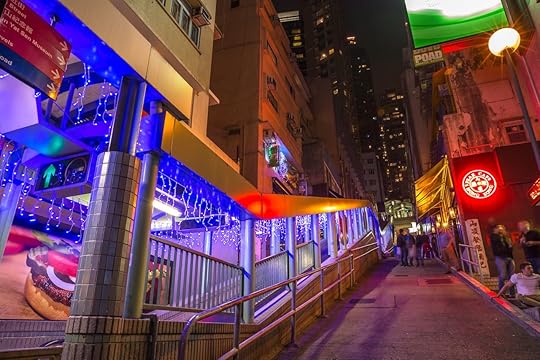
Photo: Benny Marty/Shutterstock
The Mid-Level Escalators connect Hong Kong’s central business district to the homes, shops, and restaurants located in the terraces and streets circling the city’s jungle-covered hills. For over 25 years, the Mid-Levels Escalators system has been part of the commute of Hong Kongers in the central area and used by locals to navigate up and down the steep hills of the SoHo entertainment district. The escalators themselves are pretty straightforward — they move you from Point A to Point B at a different level of elevation. Travelators, as they’re known here, are basically just moving walkways like you’d see in an airport terminal. Start your trip at the IFC Mall/Hong Kong Station and use the connecting walkways to head towards your first travelator at Queen’s Road Central.
The escalator is a one-way system that goes from south to north — or, in this case, up the hill — except during the morning rush hour (6:00-10:00 AM) when it’s put in reverse to allow commuters to use it to go down from their homes in Soho and the Mid-Levels to work in Central. In Hong Kong, it’s standard practice to stand to the right-hand side if you are walking slowly or standing on an escalator to allow for people at a faster pace to move past you on the left.
The escalator is being updated between 2018 and 2022, and different parts of it will be under maintenance at varying times. Check before you go, but remember, it’s still possible to walk the whole thing on the path and steps that run alongside the escalator system.
Why is the system useful?

Photo: Benny Marty/Shutterstock
Built in 1993, the Mid-Level Escalator helps pedestrians easily bypass the busy streets and roads below and makes the steep inclines a little more palatable in the city’s humid heat. Climbing a near-vertical sidewalk on a sweltering August afternoon is no fun — and a major deterrent for shoppers, diners, and residents making their way to work. While the escalator systems aren’t air-conditioned, they do prevent you from breaking a sweat beyond the standard state of perpetual perspiration that most everyone finds themselves in over Hong Kong’s summer months.
As a traveler, you can take advantage of the system for an incidental tour through the center of the city, with quirky second-story shops on display throughout the journey that beckon you to hop off for a quick detour. You can glance through the glass fronts of barbershops and restaurants along the way while enjoying a one-of-a-kind automated people-watching experience.
The escalators are the best way to try tons of food.

Photo: Stripped Pixel/Shutterstock
You’d be a fool to work your way all the way through the escalator system and exit on an empty stomach. The system offers walk-up access to some of the city’s best dining options. First, step off the escalator at Stanley Street and stop for a bite to eat at one of Hong Kong’s last dai pai dongs. Literally translating to “big license stall,” these open-air diners used to be commonplace around Hong Kong — however, stricter licensing and increased food safety concerns have meant all but a handful have been shut down in recent years. A meal here is best shared between a group as portions tend to be quite large. If you’re looking to try some classic Cantonese dishes, opt for the scrambled eggs with shrimp, eggplant clay pot, and clams with black bean sauce.
Hong Kong’s international culture means that global dining options abound in the SoHo area as well. You’ll find multiple places serving excellent Thai and Japanese cuisine. Check out Sole Mio for Italian, and for upscale Asian fusion, stop into Ho Lee Fook, which also takes the title for best restaurant name of all time.
Where to have a drink along the way

Photo: estherpoon/Shutterstock
Not to be missed as you work through the system is a stop at Lan Fong Yuen Milk Tea. This Cha Chaan Teng (or “tea restaurant”) on Gage Street is a Hong Kong institution, having been around since 1952. It has received particular notoriety in recent years thanks to the Instagram generation, which seems to love its retro appearance. Serving up classic Hong Kong milk tea — a sweet and creamy version of its English counterpart using evaporated milk — you can order yours served hot or iced.
Soho is known in Hong Kong for its vibrant nightlife — unlike it’s Lan Kwai Fong counterpart, the audience here tends to be slightly more mature and the focus is on good drinks in nice bars rather than 7/11 beers and raucous clubs. That doesn’t mean it doesn’t get rowdy: Staunton’s, just off the escalator system on Staunton Street, often has revelers pouring out onto the street side and is great for a casual pint.
One escalator up on Elgin Street, you’ll come across a thorough selection of bars and restaurants. Fini’s and Posto Pubblico offer a free-flow happy hour on weekdays from 5:00 to 7:00 PM while Cicada’s goes every day from 3:00 to 7.30 PM. In general, there are always options for a well-priced tipple on your journey.
What else you should do

Photo: AsiaTravel/Shutterstock
Opened after more than a decade of refurbishments, the Tai Kwun Heritage and Arts Centre can be accessed from the escalators itself — you can’t miss the striking red-brick building and wide steps leading into the courtyard. Formerly known as Victoria Prison, Tai Kwun was built as a prison and police barracks in 1841, which operated until it was finally decommissioned in 2006. The building has been tastefully refurbished and opened in 2018 as a heritage site, presenting a variety of courtyards, exhibits about the Central and Soho neighborhoods and prison history, as well as art shows and a variety of bars and restaurants.
Once you’re into Soho, you’ll notice that walls become decidedly more colorful. While there are street-art walking tours during which you can see all of the gorgeous murals from Soho to Sheung Wan, there’s a few you can see on your own within a stone’s throw from the Mid-Level Escalators. The blue-and-orange cityscape mural on Graham Street has become one of the icons of Hong Kong, and you’ll either love it or hate it. The Laughing Lady, one street over outside of a Brazilian restaurant called Uma Nota, is often a little less crowded but arguably more impressive.
And then there’s the shopping. As your strolling along — or standing on — the Mid-Level Escalators, you’ll notice that along street level there are countless stores and eateries lining the sidewalk. For quirky, Hong Kong-specific souvenirs, hop off the escalator at Wyndham Street and pop into Goods of Desire (G.O.D). This local lifestyle store has a selection of clothing, soft furnishings, candles and soaps, teas, cards, artwork, toys, and gifts with a distinctive Hong Kong flair. 

More like this: The real Hong Kong is a vast and wild natural wonder
The post How to walk your way through the dizzying escalators of Hong Kong appeared first on Matador Network.

Matador Network's Blog
- Matador Network's profile
- 6 followers



